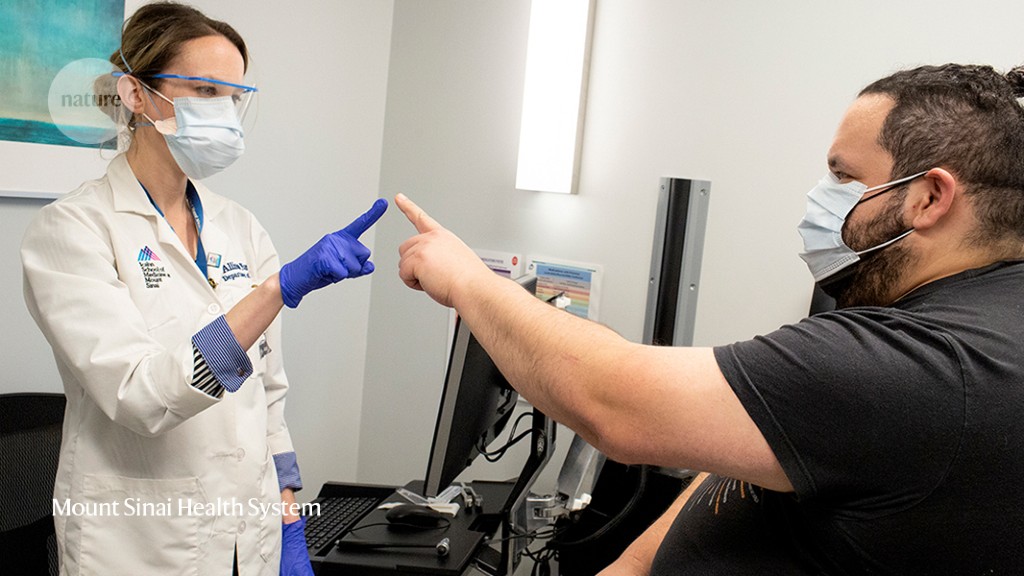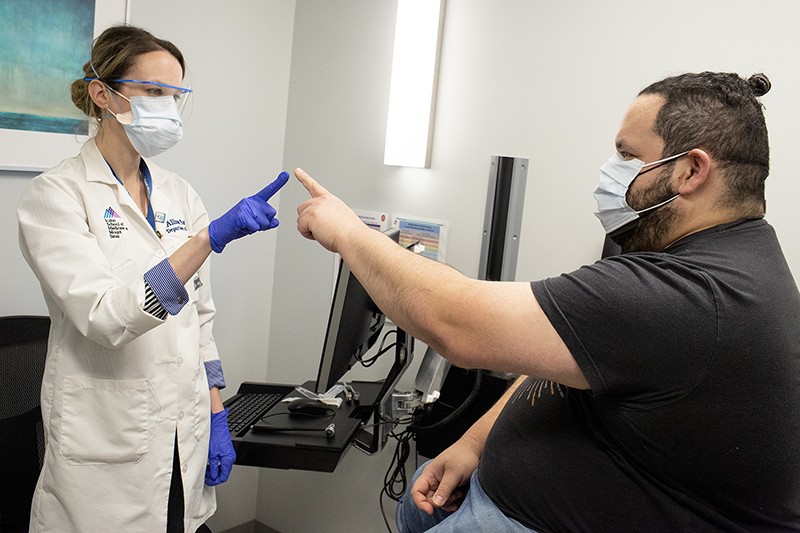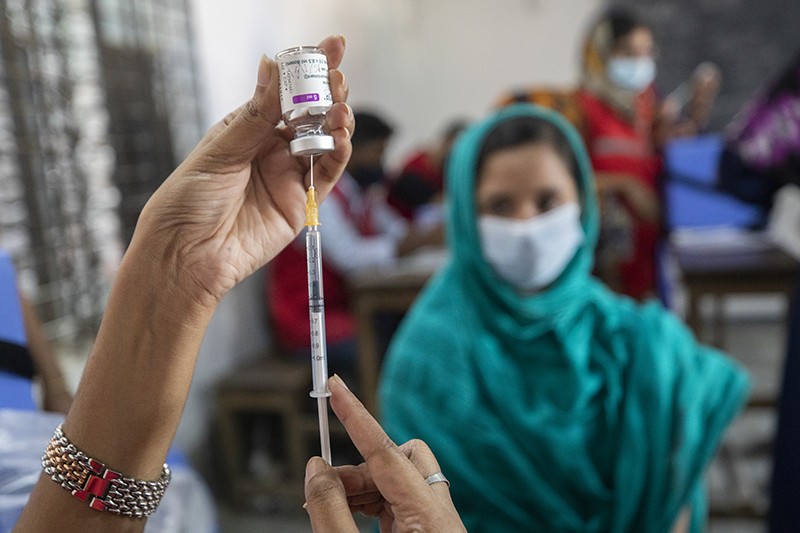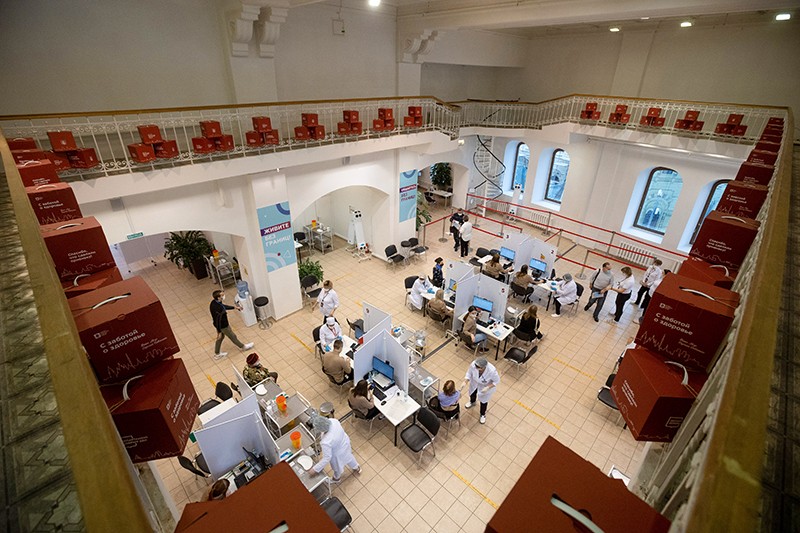Physiotherapist David Putrino’s neurological rehabilitation clinics used to treat about 50 people each week with conditions such as chronic pain, Parkinson’s disease and sports injuries. Then came long COVID.
Now, Mount Sinai Hospital’s Abilities Research Center in New York City, one of three clinics that Putrino directs, treats another 50–100 people each week who are coping with issues such as extreme fatigue, breathlessness, difficulty concentrating or any of the many other symptoms of long COVID — the long-lasting, poorly understood syndrome that can occur after infection with the SARS-CoV-2 coronavirus. He has 1,600 clients with long COVID, and more on a waiting list.
Putrino has noticed that even being fully vaccinated doesn’t necessarily protect against long COVID. Many of his clients were infected before vaccines were rolled out, and had been coping with symptoms for a year or more before they were referred to him. But he has seen about a dozen people who experienced long COVID from ‘breakthrough’ infections — in which vaccinated people catch the coronavirus. “It is noticeably less common than in unvaccinated people, but it’s still there,” he says. He thinks that clinics could see more such cases as the months tick by.
Vaccines reduce the risk of long COVID by lowering the chances of contracting COVID-19 in the first place. But for those who do experience a breakthrough infection, studies suggest that vaccination might only halve the risk of long COVID — or have no effect on it at all1,2. Understanding the prevalence of long COVID among vaccinated people has urgent public-health implications as restrictions that limited viral spread are eased in some countries. It could also offer clues about what causes lingering COVID-19 symptoms long after the acute infection has cleared.
At present, public-health officials are flying blind when it comes to long COVID and vaccination. Although vaccines greatly reduce the rates of serious illness and death caused by COVID-19, they are not as effective at completely preventing the disease, and long COVID can arise even after a mild or asymptomatic coronavirus infection. Countries with high infection rates could still end up with many cases of long COVID, even if nations have high rates of vaccination. “That is hard to predict,” says Nisreen Alwan, an epidemiologist at the University of Southampton, UK, who has had long COVID. “We still need to see how much long COVID there is and how long it lasts after vaccination.”
Determining the risk of long COVID from breakthrough infections is challenging. Many people with mild or asymptomatic infections might not be tested for COVID-19, says immunologist Petter Brodin at the Karolinska Institute in Stockholm. “Doing any kind of assessment of how many people develop long-term symptoms after they are vaccinated is going to be incredibly difficult,” he says. “We will miss so many people.”
More data should arrive as countries continue to roll out vaccines, including booster shots, and as research funding for studying long COVID is deployed — including more than US$1.1 billion from the US National Institutes of Health (NIH). Long COVID is still a poorly defined syndrome with a wide range of symptoms. A UK study estimates that between 7% and 18% of people who had COVID-19 went on to develop some symptoms of long COVID that lingered for at least 5 weeks3.
For some individuals, long-COVID symptoms are mild; for others, they are life-changing. Nearly one-third of the people with long COVID at Putrino’s clinic have severe cognitive difficulties that can affect their ability to concentrate, speak and remember, and which were not present before their illness. About 60% of Putrino’s patients have had to change jobs or stop working as a result of their illness. “If you’re young and healthy, death from COVID may be highly unlikely,” Putrino says. “But severe debilitation is not.”
The cause of long COVID — also known as the post-acute sequelae of a SARS-CoV-2 infection — is as unclear as its definition. One possibility is that a reservoir of the coronavirus lingers after the acute infection, lurking in various tissues — such as the intestine, liver or brain — and continues to cause damage. Another possibility is that the broad immune response triggered by the initial infection can generate antibodies and other immunological reactions against the body’s own tissues. That could continue to cause complications after the infection has been cleared.
Vaccination could reduce the likelihood of these scenarios. If a vaccine induces high levels of antibodies and T cells capable of recognizing SARS-CoV-2, the immune system could stop the virus during its first few replications before it can establish hidden reservoirs in the body, says Akiko Iwasaki, an immunologist at Yale University in New Haven, Connecticut.
And vaccination allows the body to launch a more-targeted immune response from the moment a coronavirus infiltrates the body, reducing the chance that nonspecific immune reactions will target normal tissue. “The immune system is already sort of pointed in the right direction,” says Brodin. “You’re calling in these very specific cells to attack this specific virus.”
Both anecdotes and data suggest that such protection against long COVID is partial at best, but it is difficult to tease out exactly how common long COVID is in breakthrough infections. One Facebook poll of about 1,950 fully vaccinated people found 44 breakthrough cases, 24 of whom reported long-COVID symptoms. The survey was done by the long-COVID patient-advocacy group Survivor Corps, and the results are reported in a preprint4. But because the poll was not a random sampling of people, the findings cannot be used to estimate the rate of long COVID after vaccination — they show only that such cases exist.
Another study in Israel, of around 1,500 vaccinated health-care workers, found that 7 (19%) of the 39 breakthrough infections produced symptoms that lingered for more than 6 weeks5. However, the numbers of infections studied are too small for firm conclusions to be drawn about the absolute risk.
One of the largest studies so far has gathered data from 1.2 million people who received at least one dose of a COVID-19 vaccine and logged their experience in the COVID Symptom Study app, which was developed by the London-based data-science company ZOE and King’s College London1. The team found that a full two-dose regimen of vaccination reduced the risk of long COVID — as defined by persistent symptoms for at least 28 days after infection — by about half among those who had breakthrough infections. But the study contained disproportionately more women than men and fewer people from lower-income areas.
Still, the message is clear, says Claire Steves, a geriatrician at King’s College London and lead author of the study. Vaccination considerably reduces infection rates and the severity of symptoms: even with waning immunity and the emergence of the more-infectious Delta variant. One study of US veterans found that the COVID-19 vaccines for that group offered about 50% protection against coronavirus infection, even during the Delta surge6. Steves and her colleagues found that vaccination then further reduces the risk of long COVID in those who develop a breakthrough infection by another half: about 11% in the unvaccinated group had persistent symptoms for at least 28 days compared with about 5% in the vaccinated group of breakthrough infections1. Even so, the number of people who developed long COVID from breakthrough infections is significant, she says. “It does still exist — we do still have to be aware that’s the case.”
Another large study2 — which has not yet been peer reviewed — suggests that the situation could be worse: a retrospective analysis of electronic health records from about 10,000 people with breakthrough infections found vaccination did not protect against several conditions associated with long COVID. That group was compared with a control group of people with confirmed SARS-CoV-2 infections who had not been vaccinated against COVID-19, but who had received an influenza vaccine. Differences in how the two studies were designed could account for the different results generated by this work and the COVID Symptom Study, says Maxime Taquet, a psychiatrist and researcher at the University of Oxford, UK, who is first author of the health-records analysis2. For example, Taquet’s study tried to account for potential lifestyle differences between those who received the COVID-19 vaccine and those who did not by including the control group. However, because his study relied on health records, it might not include data for people with milder symptoms that would not have warranted a consultation with a physician.
Overall, Iwasaki has found the results of these studies disappointing. “I honestly thought the vaccine would protect against long COVID much more extensively,” she says. Iwasaki proposes that Delta — which is more transmissible than other variants are — might have weakened the vaccines’ protection against long COVID. If people infected with Delta breathe out a great number of infectious particles, as is thought, the infections that they pass on will have higher initial amounts of virus. That could allow Delta to replicate more readily than other variants, even in fully vaccinated people, says Iwasaki. This higher dose could give the virus a better opportunity to establish a reservoir or provoke an overactive immune response, either of which might then lead to long COVID, she suggests.
As vaccination programmes continue, researchers will gain a better sense of how vaccines and variants affect long-COVID rates and severity. It’s also possible that vaccination might help to reduce long COVID in those who already have the condition. In October, the UK Office for National Statistics, which is collecting data on long COVID, reported that the first dose of a COVID-19 vaccine was associated with a 13% decrease in self-reported long-COVID symptoms among those who already had the condition. The second dose yielded a further 9% drop relative to the first7.
The study followed people for only about two months, so it’s unclear how long the effects will last, says Iwasaki, who has been studying how vaccination affects long-COVID symptoms. But it is largely in line with other findings, she adds. One survey conducted by Survivor Corps found that about 40% of respondents with long COVID reported an improvement in their symptoms after vaccination. Another 14%, however, said that their symptoms got worse8.
The US Centers for Disease Control and Prevention is not tracking mild COVID-19 breakthrough illnesses, and so might miss many cases that lead to long COVID. However, last December, the US Congress allocated the NIH $1.15 billion over 4 years to study the long-term health consequences of SARS-CoV-2 infections; in June, the NIH granted the first awards for a long-COVID research programme called RECOVER. This aims to enrol tens of thousands of people — including those with or without long COVID after acute coronavirus infection, and those who have not been infected — and track their symptoms. One of the main goals is to learn more about the pathology of long COVID and to better define the condition.
Over the course of that study, the RECOVER team should also be able to generate data on rates of long COVID among those who are vaccinated. Other useful information should include the severity, duration and nature of a person’s symptoms and, when possible, the coronavirus variant responsible for their illness, says cardiologist Stuart Katz at New York University, a lead investigator on the programme who has also experienced long COVID. “We are enrolling people and recording the history of vaccination,” says Katz. “But, of course, a big challenge for any research in this space is that we don’t yet really have a definition of what long COVID is.”
The team hopes to finish enrolment in the programme’s first year — a speedy pace for such a large initiative, but still painfully slow given the pressing need to improve treatments for long COVID, says Iwasaki.
RECOVER will also collect data on vaccinated children and adolescents — an important gap in currently published studies, and one that will be easier to fill as vaccines are rolled out to young people in several countries. One study9 of more than 6,700 adolescents found that about 30% of those who tested positive for SARS-CoV-2 had 3 or more symptoms 3 months after diagnosis, compared with 16% of those in a control group that tested negative. The findings from the control group, a factor not included in most other such studies in this age group, bring the rate of long COVID down below some other estimates for adolescents, but means that it is still comparable to the rate seen in adults, says paediatrician Terence Stephenson at University College London. “It’s not the tsunami that perhaps was envisaged,” he says. “But neither is it trivial.”
And while the data trickle in, Alwan worries that countries with high vaccine coverage will put COVID-19 testing on the back burner as concerns about hospitalizations and deaths decrease and as more people receive boosters. That not only hurts efforts to determine the influence of vaccination on long COVID, but also means that those with long COVID after a mild or asymptomatic infection might not have the documentation they need for treatment. “It’s important to get that lab confirmation for care,” she says. “Otherwise, people struggle a lot.”








More News
Finding millennia-old ‘monumental’ corals could unlock secrets of climate resilience
Argentina’s pioneering nuclear research threatened by huge budget cuts
The dream of electronic newspapers becomes a reality — in 1974